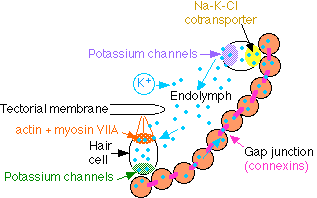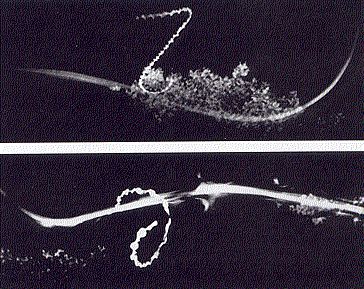
| Index to this page |

The sense of hearing is the ability to detect the mechanical vibrations we call sound.
Sound wavesThe middle ear is filled with air and is connected to the outside air by the eustachian tube, which opens into the nasopharynx. Opening of the tube — during swallowing or yawning — equalizes the air pressure on either side of the eardrum.
Allergies or a head cold may inflame the walls of the eustachian tubes making them less easily opened. Rapid changes in pressure at such times — such as descending in an aircraft or during a SCUBA dive, may be quite painful because of the unequal pressure against the eardrums.
 Vibrations of the innermost ossicle, the stirrup, are transmitted through a flexible membrane, the oval window to the cochlea of the inner ear.
Vibrations of the innermost ossicle, the stirrup, are transmitted through a flexible membrane, the oval window to the cochlea of the inner ear.
The cochlea is a tube, about 3.5 cm long, that is coiled like a snail shell and filled with a special fluid called endolymph. The most dramatic difference in the composition of endolymph from other lymph in the body is its high concentration of potassium (K+) ions.
Running through the cochlea for its entire length is a plate of bone and an inner tube that is also filled with endolymph. These structures divide the outer tube of the cochlea into two separate chambers.
Because liquids are practically incompressible, it is necessary to have some way of relieving the pressures created when the oval window is pushed in and out. The flexible round window does this by moving in the opposite direction.
The organ of Corti lies within the middle chamber of the cochlea. It contains thousands of hair cells, which are the actual vibration receptors. The apical surface of the hair cells contains an array of stereocilia, which give the hair cells their name. Stereocilia are not built from the "9+2" arrangement of microtubules that are found in true cilia.
The hair cells are located between the basilar and tectorial membranes. Vibrations of the endolymph cause vibrations of the basilar membrane. This moves stereocilia at the tips of the hair cells against the tectorial membrane and open potassium channels in them. The influx of K+ from the endolymph depolarizes the cell.
You should note that hair cells differ from most "excitable cells" (neurons and muscle fibers) in their use of potassium ions, not sodium ions, to depolarize the cell.| Link to a discussion of excitable cells. |
Depolarization of the hair cell causes the release of a neurotransmitter (probably glutamate) at its basal surface and the initiation of nerve impulses in a sensory neuron that synapses with it. These impulses travel back along the auditory nerve (the 8th cranial nerve) to the brain.
Many people, especially when young, can hear sounds with frequencies (pitches) from as low as 16 to as high as 20,000 hertz (cycles per second). Detection of a given frequency is a function of the location of the hair cells along the organ of Corti with the highest frequencies detected near the base of the cochlea, and the remainder of the sound spectrum detected in a progressive fashion with the lowest frequencies detected by hair cells near the tip.
If a laboratory animal is exposed to very intense, pure tones, it eventually becomes deaf to those frequencies, but its ability to hear other pitches is unimpaired. Examination of its organ of Corti reveals destroyed hair cells in a single area whose location can be easily correlated with the pitch of the destructive sound.
Similar deficits occur in humans who are exposed to intense noises for long periods. (A trained audiologist can tell by looking at the frequency response whether a patient flies private aircraft.)About 1 newborn in a thousand is born deaf because of a genetic defect. As the years go by, many of us (~16%) suffer a progressive loss of hearing because of genetic defects.
Literally scores of genes have been identified in recent years whose mutant versions result in hearing loss.
| Link to a discussion of gap junctions and connexins. |
| Link to discussion of active transport. |
Just above the cochlea are two interconnecting chambers filled with endolymph, the sacculus and utriculus. On their inner surface are patches of hair cells to which are attached thousands of tiny spheres of calcium carbonate (CaCO3). Gravity pulls these downward. As the head is oriented in different directions, these ear stones or otoliths shift their position. The action potentials initiated in the hair cells are sent back to the brain.
Motion of the body is detected in the three semicircular canals at the top of each inner ear, each one oriented in a different plane. There is a small chamber at one end of each canal containing hair cells. Whenever the head is moved, the fluid within the canals lags in its motion so that there is relative motion between the walls and the endolymph. This stimulates the hair cells to send impulses back to the brain.
When the hair cells send messages that are incongruent with what the eyes are seeing and our body is feeling, as may occur in a boat or aircraft during rough weather, motion sickness can result.
Some people also suffer severe dizziness because otoliths have become dislodged from their utriculus (e.g. following a blow to the head) and settled in a semicircular canal.
Bats can hear frequencies as high as 150,000 hertz. Sound at these ultrasonic (to us) frequencies travels in fairly straight lines. Bats flying in complete darkness are able to locate obstacles and even insect prey by emitting pulses of this ultrasonic sound and then adjusting the course of flight to the echo that returns to their ears. Such a system of echolocation works on the same principle as sonar for submarine detection.
 |
| A blindfolded bat can fly between the wires touching them only rarely. A bat whose ears are plugged collides repeatedly with the wires. |
 |
| Hunter and hunted. In the top photo, a moth (bright streak) takes successful evasive action upon detecting the approach of a bat (broad streak across the photo). (The diffuse image is a tree in the background.) In the bottom photo, the two streaks intersect, indicating that this time the moth was unable to escape capture by the bat. (Photos by Frederic A. Webster, courtesy of the late Prof. Kenneth D. Roeder.) |
| Welcome&Next Search |